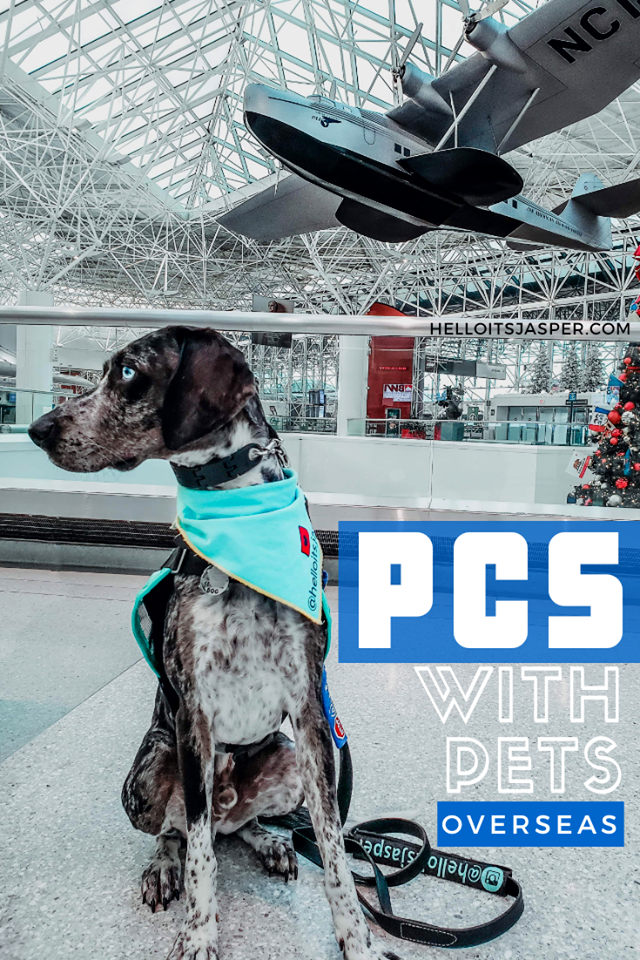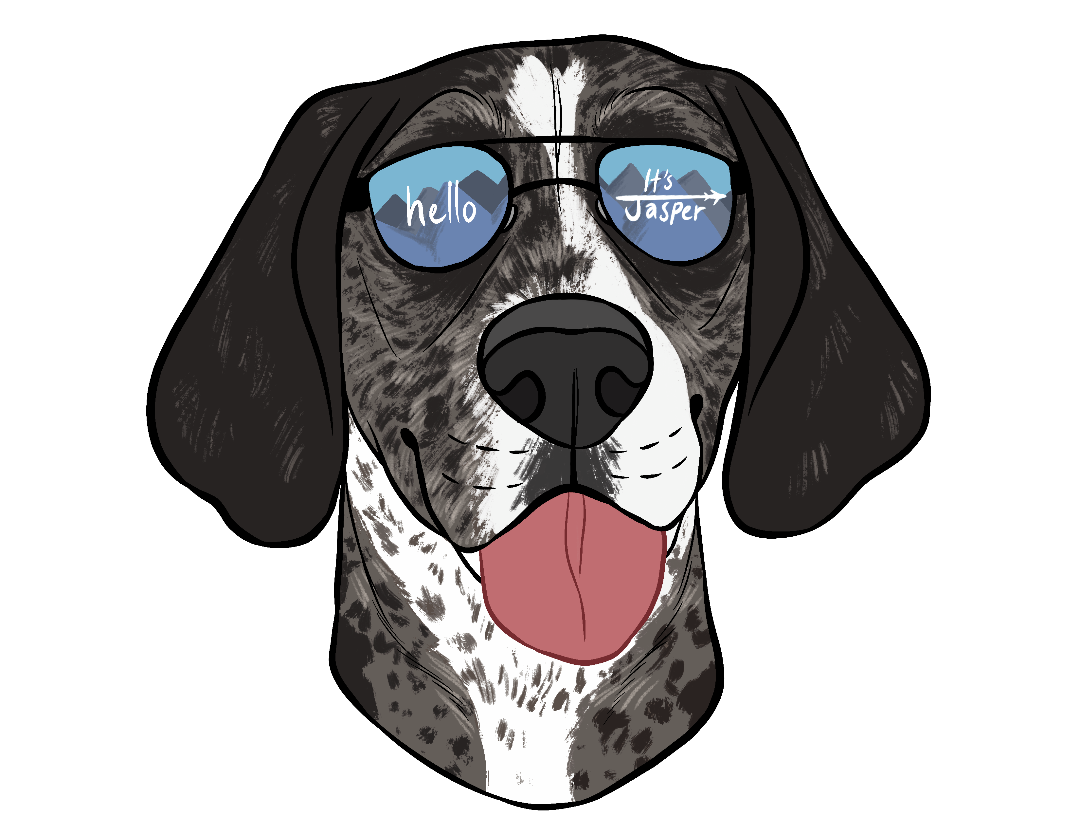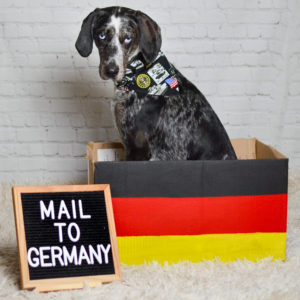
PCS With Pets to Germany
Hello, it’s Jasper! Did you just receive orders for your first OCONUS move with a pet? Are you unsure of what you need to move your furry pal abroad? We’ve been there. Overseas moves are no joke. For months, our family spent countless hours scouring the internet to ensure we had all the information we needed for a seamless move. We’re here to save you the hassle and give you the easy breakdown. You shouldn’t have to stress the PCS just because you have a fur baby.
Orders
If you are anything like Dog Mom, you are preparing well before you even have your official orders. Once you receive your orders, the first thing you want to do is look at what country you will be stationed in. Your duty station actually effects what shots and documentation your pet will need because each country has their own import laws for pets.
APHIS

The import requirements for each country can be found on the Animal and Plant Health Inspection Service website. There, you will locate a blue and tan box that discusses exporting your pet from the United States. In this box, there is a drop-down which allows you to select your destination. This drop-down is where you will choose the country you are traveling to.
Once you have selected the country, you will then be taken to a web page that asks for the type of pet being imported. An ordered list of steps will then be provided in a drop-down. This is where you will locate the vaccinations and documents you need for your pet. Be aware that although an animal is allowed in the country, the base may not allow the animal (Example: Ferrets are not allowed on base in Germany, but they are allowed to be imported to the country).
You can access the website via this link: Animal and Plant Health Inspection Service
Country Requirements
Mandatory quarantine periods exist in many countries, such as Japan. This means that your pet will go to a facility where they are monitored for signs of illness for a specified amount of time. The quarantine period can range from one hour to possibly 120 days. We moved to Wiesbaden, Germany and there is no quarantine for pets in this country.
Microchips will be necessary for almost any country you PCS to. If your pet already has a microchip, ask your vet to check that their chip fits the destination country’s requirements. For example, Germany requires a fifteen digit microchip number that is ISO compliant. If your pet’s microchip does not meet this requirement, your pet must travel with a chip reader that is compatible with their chip.
Rabies vaccinations are also a resounding requirement for most OCONUS duty stations. An important detail to note is that your pet’s rabies vaccination must take place on the same day or after their microchip implantation. The reasoning behind this is to ensure that the correct pet is identified as having received the rabies vaccination. Being micro-chipped before the rabies vaccination is administered allows for the vet to provide the pet’s microchip number on the their rabies documentation. Some countries, such as Germany, require the rabies vaccination to be administered a minimum of 21 days before the pet’s arrival in the country. Make sure you bring your pet’s signed rabies vaccination certificate when traveling.
Vaccination requirements will vary based on the country you are traveling to. Some countries only require the rabies vaccination, but others have extensive vaccination lists. There may also be requirements for the vaccinations to be completed a certain amount of time before arriving in the country. For example, Germany requires the rabies vaccination to be administered at least 21 days before landing in the country.
Breed restrictions may exist in the country you are moving to. Be sure to research your destination’s restricted breed list. In addition, some airlines restrict travel for certain breeds. If your pet is not listed on the country’s restricted breeds list, but they are prohibited by the airline you are flying with, then I highly recommend a pet shipper. Please feel free to reach out for our pet shipper recommendations!
Health Certificates are required to ensure a pet is healthy for travel and importation into another country. These certificates must be completed by a USDA Accredited veterinarian or an APHIS veterinary medical officer (aka an on base military vet). Having your pet’s health certificate completed by an accredited vet is extremely important. All military vets will be accredited, but if you are unable to make an appointment on base, then seek out a vet who is USDA accredited off base. In addition to this, there are a variety of requirements for your health certificate to be considered valid.

- The health certificate must be completed by an accredited vet within 10 days of landing in the country. As bad as you want everything done early, the health certificate is not considered valid if it is completed more than 10 days before landing in the country. I will stress again that this is within 10 days of landing in the country, not within 10 days of your flight.
- I cannot stress enough that a USDA accredited veterinarian or an APHIS veterinary medical officer must complete this health certificate. We had the craziest roller coaster trying to have our dog’s health certificate completed by an accredited vet. Despite verifying that we had an appointment with an accredited vet three times, the facility we originally booked with still made an appointment for us with a vet who was not accredited. This left us scrambling to find an available vet at the last minute. Since we stayed with family before PCSing to Germany, a military vet wasn’t an option for us. Luckily, Henry County Animal Hospital was kind enough to squeeze us in at the last minute (If you are stationed in Georgia, we highly recommend their services).
- The health certificate must be completed by the veterinarian in blue ink to be considered valid.
- You must present the original health certificate when traveling (a copy will not be accepted).
- The document is six pages and each page must be labeled with it’s number (Example: Page 1 of 6). There will also be a seventh page labeled as “Page 1 of 1” that details your pet’s microchip and health certificate number.
- The health certificate must be in two languages (English and the country’s native language). This ensures that the vet can easily read the certificate when you land.
Moving to Germany? You can locate your health certificate via this link: Health Certificate
Endorsing your pet’s health certificate is essential. If this documentation is completed by an APHIS veterinary medical officer (aka a military vet), then having it endorsed is not required. Health certificates obtained from USDA Accredited Veterinarians, however, must be endorsed by APHIS. To have your pet’s health certificate endorsed, you will make an appointment with your local USDA APHIS Veterinary Services Endorsement Office. What should you know before attending your appointment?

- All animals who receive their health certificate from an USDA Accredited Veterinarian must be endorsed. This includes service animals and emotional support animals. There is no exception.
- Schedule your appointment in advance. Your local endorsement office may not allow walk-ins. We scheduled our appointment over a month in advance and still had difficulty obtaining a time slot.
- Have your pet’s completed health certificate before your appointment. We scheduled our endorsement for the day after our health certificate appointment.
- Be sure that your health certificate meets all the guidelines that I outlined above or it will be rejected by the endorsement office. While waiting for our appointment, we witnessed two owners have their documentation rejected. One owner was rejected because the documentation was completed in black ink instead of blue. The other owner was rejected because the veterinarian’s signature date did not correspond with the documented date of the pet’s physical exam. Check your documents with a fine tooth comb before your appointment.
- Make sure to bring your pet’s shot records, proof of ownership, and their official rabies vaccination certificate.
- Prepare for the fees that you will be charged. Ensure that you are aware of what forms of payment they accept, such as cash or check.
- Do not bring your pet to the endorsement appointment. Only trained service animals are allowed inside of the endorsement offices.
Find your local endorsement office via this link: USDA APHIS Veterinary Services Endorsement Office
Airport Departure & Arrival

Once you arrive at the airport, pets are required to remain inside of their Kennel at all times. If your pet needs to stretch their legs or use the restroom, there are designated pet relief areas throughout every airport. These relief areas can be located on the airport’s website.
Upon check-in for your flight, your pet and their kennel will be weighed together. Some airlines charge based on weight (Pet + Kennel), but other airlines charge a flat rate for the transportation of animals. During this check-in process, the airline will verify your pet’s kennel and documentation meets the requirements for travel. Have questions on how to prepare your pet’s kennel? We’ll have a blog post to assist you soon!
If you are traveling on a military flight, prepare for the fact that each passenger, pet, and luggage item will be weighed (This includes animals flying in the cabin). Military flights do place a weight limit on your personal items. You may be given the opportunity to pay for the items that go over this weight limit, but it is not guaranteed.
The check-in process for military flights takes a very long time. Our flight did not leave until late at night, but check-in started at noon. After checking in, passengers had to wait by the check-in counters until after 5:30 p.m. with their pets. After this time, passengers were able to hand over their animals to the airline and begin their journey through security.
When you arrive overseas, there will be a veterinarian who must examined your animal. For us, this took place in the baggage claim area. There will be a fee charged by the veterinarian for this exam (The cost varies by country). After the exam is complete, you will receive a stamped and signed document from the veterinarian. You will need this document to legally enter the country with your pet. If you are struggling to locate the veterinarian, ask a worker because you cannot skip this exam.
Tips

Bring a printed copy of a blank health certificate to your veterinarian (Make sure that it is specific to the country you are moving to). The facility we utilized provided their own printed copy of the health certificate, but that does not mean every facility will. We brought multiple printed copies from home as a precaution.
Be prepared for the cost. Your pet’s health certificate, vaccinations and endorsement will cost money. In addition, there will be fees for shipping your pet and exam fees once they arrive at your destination. Not to mention, there is also the cost of their travel crate and bowls. The military does not cover or reimburse any expenses for moving an animal.
Keep you pet’s documentation on you at all times. When checking in for your flight and arriving at your destination, you will be asked to present you pet’s documents. Make sure you always receive these back and do not lose them. A copy will not be accepted when you land, only originals are considered valid. Important documents: Endorsed Health Certificate, Rabies Vaccination Certificate, Vaccination Record, & Military Orders
Have multiple copies of your orders (with your family notated on them). We had to provide copies of our orders at check-in, during the flight, and twice upon arrival. In addition, you will need to provide your orders at the military hotel. Be sure that the orders you provide have your family notated on them. I recommend bringing at least four copies of your orders.
Regardless if your animal is traveling in cabin or in cargo, you must book a space with the airline. Airlines require booking for animals traveling via cargo, but you must also do this for animals traveling in cabin. If your animal is traveling in cabin, be aware that the airline reserves the right to limit the number of animals allowed in the cabin during a flight. Make sure to have the appropriate documentation for in cabin travel. This documentation may include a physician prescription and airline specific documents for flights longer than 8 hours (In addition to your animal’s other documentation). Be aware that the U.S. Department of Transportation is currently reviewing legislation that would allow airlines to refuse emotional-support animals for in cabin travel.
Register your pet with the on base vet as soon as possible. In Germany, our base required us to register our dog within 2 weeks of arrival. In addition, we had to obtain an EU Passport within 4 months of arriving in Germany.
PCSing with pets can be overwhelming (believe me, we’ve been there). Have questions or concerns about your upcoming PCS? Woof at us below! If we don’t know the answer, we probably know someone who does.



